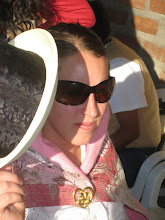Today was kind of intense…maybe thought provoking is a better way to put it. I watched a movie about Sendero Luminoso (Shining Path) in my Spanish class. The Sendero Luminoso was a Maoist group created in Peru in the 1970’s among the rural population with the goal of generating a completely different vision for Peru. Unfortunately, they relied on violence to accomplish their mission and thousands of innocent people were killed in the process. Government attempts to temper the revolution were likewise violent and the corrupt politics of Alberto Fujimori led to further human rights violations. Anyway, what is more important than the actual details of this period is to think about the impacts that such atrocities can have on a population, on an individual. I don’t think it’s really possible to fathom, but it’s imperative to realize how very real it is and that it does happen. (I would recommend that everyone read “The Little School” by Alicia Partnoy for a better understanding of what I mean. It is one woman’s actual account of life in a detention center during the Dirty War in Argentina.) Furthermore, it is necessary to recognize that genocide and disappearances persist today in various countries around the world. While they may not be happening in our own backyard, other human rights violations probably are. Severe inequalities exist in the U.S. as well.
To follow that up, a couple of people came from the U.S. embassy to give a presentation on the U.S. free trade agreement (TLC) which Peru will most likely sign before too long. Basically, it was exactly what I expected to hear—a stereotypically optimistic, glossed-over spin on free trade. In short, what the TLC will do is encourage more global trade and especially trade between the U.S. and, in this case, Peru. The most annoying part was that the main speaker tried to tell us that the agreement is environmentally friendly. The speaker based his argument on the fact that the TLC will hold Peruvian companies and factories up to U.S. environmental standards. Okay, but since when has the U.S. been a leader in clean production practices? How do you explain the tons of pollutants dumped directly into Lake Michigan by BP all under the guidance of the EPA? Also, is more “development” in the U.S. TLC sense of development really a positive thing? Increasing the number of factories and hotels in Peru doesn’t exactly seem like a smart environmental move. Last time I checked, the U.S. was responsible for more carbon emissions than any other country. Are we a good model for development? If anything, we, who by this point should be aware of massive environmental degradation and global climate change, should be encouraging the purchase of local goods and a reduction of consumption. Do we really need apples from Chile, cotton from Peru and everything else from China? Just maybe, we (as in the U.S.) are pushing for the signing of the TLC because we need it to sustain our own economic system and our own quality of life.
Anyway, I just thought I’d throw out a couple of hugely complex issues for you to ponder! My sister warned some of you that my blogs would turn into ridiculous, overly analytical reflections, so I didn’t want to disappoint.
Monday, October 8, 2007
Subscribe to:
Post Comments (Atom)

No comments:
Post a Comment